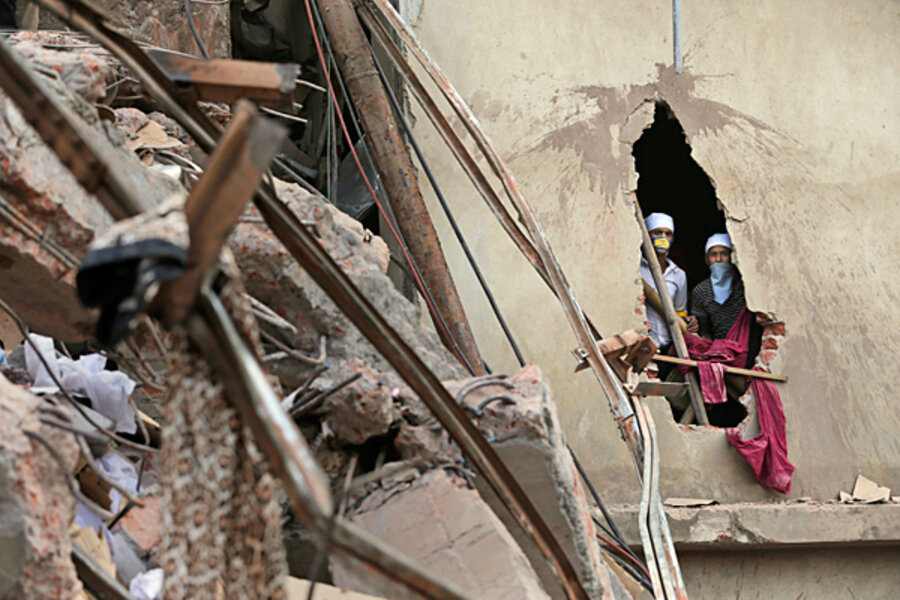Q&A: Who ultimately bears responsibility for Bangladesh factory disasters?
Loading...
When an eight-story factory outside Bangladesh’s capital Dhaka collapsed Wednesday, the ensuing devastation was met with horror (more than 200 were killed), but not disbelief.
Catastrophic industrial accidents are something of a regular occurrence in the south Asian nation, which is the second-largest garment exporter in the world. Lax labor and building standards, coupled with a rock bottom minimum wage for garment workers ($37 per month), have played a large part in that boom, though at a high cost.
In fact, only five months ago, a fire at another factory in the city killed 111, prompting a flurry of apologies and promises of reform from both the Bangladeshi government and the western companies whose goods were produced there, including Walmart.
But who ultimately bears the responsibility for these disasters – and can they be stopped? The Monitor spoke to Aman Singh, editorial director of the CSRwire, a website for corporate social responsibility news, about consumer choices, the supply chain blame game, and who sets the standards for global garment production.
When a disaster like the one in Bangladesh occurs, everyone involved immediately starts pointing fingers – at the factory owners, at the government, at the Western companies who source goods there. So whose fault is it?
The chain of command between retailer and source is purposefully pretty complex. And in the middle of the chain of command you have all these different players – the subcontractors, the auditors, the analysts, the people negotiating these contracts every year. Because the responsibility is so thinly distributed, no one person or group of people is really being held accountable for compliance with building standards, say, which makes it really hard to pinpoint where the issue started.
And then you have companies like Walmart that come forward and say, we contract out to suppliers, so we don’t even know if our products were made in this factory or not. Is that a good excuse?
No, it’s really not. Walmart is so big and so powerful that they really could go to any supplier they want and say, stick to our wage and safety policies or get out. And they can do that far more effectively than government legislation ever could. These companies have more power than entire governments, entire nations.
It sounds like the corporate supply chain is often very opaque – is there any attempt being made to change that on a global level?
That’s the million dollar questions we’re all trying to answer: We have to work in a global economy, we have to work with different understandings of what’s acceptable in terms of labor and workers. It’s acceptable culturally, for instance, for women as young as 14 to work in a lot of countries. But it’s not OK in the UK or US markets.
The UN is trying to standardize this supply chain management. The International Trade Center has a standards map out that’s visible online, and what they’re trying to do is bring all these apparel companies together to see what standards everyone is using and where they stand against their peers. They’re billing it as a competitive advantage for companies. It’s an interesting strategy because we all know when [labor practices] impact the dollar they’re all going to want to be interested in making them better. The maps are only available to the companies participating now, but the hope is to make it publicly eventually. And I think when that kind of information becomes public it’ll force companies to be more transparent in their supply chain policies.
What about consumers – do disasters like this change their buying habits?
I don’t know if they’re really impacting consumers – I don’t know if they’re really starting to come out and say, you know what, I’m not going to buy from this company because this kind of thing is just happening way too often. There’s a real gap there. We as consumers have a very short memory and we tend to forget these disasters after they happen.
Since I’ve started working in this field though, I have really changed my shopping habits. The biggest shift is I’ve become far more conscious of how much I buy. I try to not over-consume. I’ve realized that the core of our problem is over-consumption. But also buying very cheap goods is a part of it: If you’re paying $5 for a pair of pants, you can only assume the person making them is getting much less than that, although volume does play a huge factor in price margins and wages.
But if you pay more, does that guarantee the conditions the garment was made under were any better?
That’s true. There’s no way of making that correlation.
Is there any way for consumers to know from the information on their garment – the brand, the country it’s made in – if they’re getting something produced under decent conditions?
The problem is we don’t have any labeling with clothing that identifies ethical sourcing. It almost always requires going back to the Internet and looking at their supply chain policy. Many brands are starting to put their whole supply chain on their website, but from a consumer perspective who has time to do that? You want to be able to just pick up a piece of clothing and know if it has an ethical history. And right now you can’t.
In the late 1990s, Nike and other major sporting apparel companies faced a large protest movement led by American college students against the labor conditions in their factories. It forced them to reexamine a lot of these kinds of problems. Is any similar movement building now?
Activism had such a big role to play at that time. And it still does. But that activism has slowly changed into collaboration – the NGOs that once fought these companies are now working with them. And obviously the companies prefer that because they have a partner rather than someone working against them. But I think for Nike the protests and their extremely public nature was the big motivator in changing their policy. And I think we need more of that. Apple for example: What is stopping us from saying we're going to stop using its products until it proves it can provide better working conditions in its factories? Do we as consumers have the courage to boycott some of our favorite brands over ethics?
Overall, when you look at supply chain issues around the world, are you optimistic? Is the world trending towards progress?
It’s such a complex sector. We’re doing better in so many things but we’re starting to go the wrong way in so many others that it’s hard to stay optimistic for too long. Incidents like these tell us the road ahead is long and will require continuous courage.








